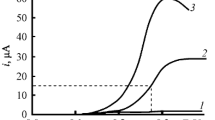Abstract
An investigation has been made of the formation of glyoxylic acid by the electrochemical reduction of oxalic acid/sulphuric acid aqueous solutions at various temperatures and cathode potentials using lead electrodes.
It has been found that for a given quantity of electricity passed greater current efficiencies are obtained at higher electrode potentials and lower temperatures. The current efficiency decreased with increasing quantity of electricity passed.
A simple analysis for the process has been made in which glyoxylic acid is assumed to be reduced to glycollic acid. By incorporation of a variable factorf, to take into account electrochemical parameters for the two reactions, satisfactory predictions of the current efficiency have been obtained. The electrokinetic interpretation of thef-factor is also briefly discussed.
Similar content being viewed by others
Abbreviations
- C A,C B,C C :
-
Molar concentrations of species A, B, and C respectively (mol cm−3)
- C A0 :
-
Initial concentration of A (mol cm−3)
- F :
-
Faraday = 96 500 Coulombs (As)
- f :
-
Current efficiency correction factor (=i A/i B)
- I :
-
Cell current (A)
- i A,i B :
-
Current densities for reactions A → B and B → C respectively (A cm−2)
- \(i_{0_A } , i_{0_B } \) :
-
Exchange current densities for reactions A⇌B and B⇌C respectively (A cm−2)
- Q :
-
Quantity of electricity passed (=It) (As)
- t :
-
Time (s)
- V :
-
Catholyte volume (cm3)
- α A,α B :
-
Transfer coefficients for reactions A→B and B→C respectively
- η A,η B :
-
Overpotentials associated with reactions A→B and B→C respectively (V)
- η :
-
Cathode overpotential (V)
- γ :
-
Current efficiency for reaction A→B
References
M. E. Royer,Compt. rend.,69 (1869) 1374.
J. Tafel and G. Friedrichs,Ber,37 (1904) 3187.
E. Baur,Z. Elektrochem.,25 (1919) 102.
W. Mohschulz,Z. Elektrochem.,32 (1926) 434.
H. Nakata, Annivers. vol. dedicated to M. Chikashige, Kyoto Imp. Univ. (1930) 49.
V. V. Listopadov and L. I. Antropov,Nauch. Trudy Novocherkassk Politekh Inst,34 (1956) 87.
G. M. Florianovich and A. N. Frumkin,Doklady Akad. Nauk S.S.S.R.,79 (1951) 997.
G. M. Florianovich,Zhur. Fiz. Khim.,31 (1957) 626.
M. Smialowski and J. Jarmolowicz,Bull. acad. polon. sci. Classe III,3 (1955) 107.
L. I. Kudryashov and N. K. Kochetkov,Tr. Mosk. Khim. Tekhnol. Inst.,49 (1965) 111.
N. K. Kochetkov and L. I. Kudryashov,Tr. Mosk. Khim. Tekhnol. Inst.,54 (1967) 207.
S. Yoshikawa, Japanese Patent 9966 (1958).
F. D. Rossiniet al., ‘Selected Values of Chemical Thermodynamic Properties’, Circular 500, U.S. National Bureau of Standards, Carnegie Press, Washington (1952).
K. S. Yap, M.Sc. Thesis, University of Manchester (1971).
Author information
Authors and Affiliations
Rights and permissions
About this article
Cite this article
Pickett, D.J., Yap, K.S. A study of the production of glyoxylic acid by the electrochemical reduction of oxalic acid solutions. J Appl Electrochem 4, 17–23 (1974). https://doi.org/10.1007/BF00615902
Received:
Issue Date:
DOI: https://doi.org/10.1007/BF00615902



